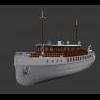-
Posts
1,171 -
Joined
-
Last visited
Reputation Activity
-
 jud reacted to JerseyCity Frankie in ratlines,tarred or not?
jud reacted to JerseyCity Frankie in ratlines,tarred or not?
I have a history of doing maintenance work on historic sailing ships and I have painted on a fair amount of pine tar in my day. Landlubbers often think the tar we talk about when we talk about Tar is asphalt tar, a not too good smelling petroleum industry byproduct used in road maintenance on land. Easy to mistake it with Pine Tar if you don’t use your nose since the two products are shiny black and gloopy. But those of us who use Pine Tar on ships all agree it’s the most lovely smelling substance, perhaps in all the world. Some even say its an aphrodisiac.
But I digress.
Traditional pine tar is made by heating the roots of pine trees in the absence of oxygen, which produces charcoal and pine tar. http://en.wikipedia.org/wiki/Pine_tar and this nice essay on tar is worth a look too: http://www.maritime.org/conf/conf-kaye-tar.htm
Nobody on modern tall ships paints tar on their ratlines, but neither do modern sailing vessels use natural fiber line as ratline stuff. Unlike natural fiber line, modern Dacron line is impervious to rot and requires no coatings. But natural fiber line can last longer in a marine environment if its painted or impregnated with tar.
Tar can and often should be cut with turpentine or linseed oil or both, this allows it to flow better and penetrate the fibers of a rope. Full strength unadulterated tar has the consistency of molasses and appears black and is very gloppy. Its not really pigmented and if painted onto a white nonporous surface it will appear to be a streaky dark brown film, it will not behave like black paint which has pigment particles suspended in it and will thus “cover” the same white surface the tar would only smear.
Also the paint will dry in a day while the tar remains very sticky for quite a long while, it remains sticky for weeks. Repeated applications of tar will eventually produce a thick black opaque coating and this is why shrouds and standing rigging is black, they have many coats of tar applied to them eventually leading to a hard shell of tar which keeps the water out and the Ultraviolet Radiation can’t penetrate. Despite modern man-made-fiber lines imperviousness to rot, it still can be harmed by U.V. radiation and this is why it is sometimes tarred but I have read that black paint is often used on modern ships in place of tar since it performs the same U.V. blocking function, LOOKS like tar and is also universally available while Pine Tar can be hard to come by in our modern age. But back in the old days Pine Tar was ubiquitous. Today small quantities are available at tack shops for the horse riding trade.
If you paint Pine Tar on canvas (which I tried once) it turns the fabric an olive drab color and makes it heavy and waterproof and this is where we get Tarpaulin. Paint it on manila line and it darkens it slightly but not so much that you would tell the difference right away between a painted and unpainted piece of line. Put four coats on manila and you will certainly see the color shift to a darker hue but nowhere near black, the line now fairly waterproof and very sticky.
Getting finally to the point, the long way, I am sure pine tar was painted on ratlines. Also I am sure pine tar was already in the rope when it arrived at the ship, having been applied at the ropewalk in a thinned solution or rubbed on with a rag to produce a coating that would penetrate the fibers and add to the lines longevity. But I don’t think it would have been applied in thick enough or repeated coatings sufficient to make the ratlines black. I imagine the bo’sun would have thin tar applied to the ratlines whenever they started to appear dry or took on a chalky chaffed appearance but I do not know that for a fact, I just surmise it from my own experience.
-
 jud got a reaction from riverboat in Work Table Light needed
jud got a reaction from riverboat in Work Table Light needed
Noticed that, and was thinking about how many candles I could buy instead and be grid free.
jud
-
 jud reacted to overdale in automotive pin stripe sticker
jud reacted to overdale in automotive pin stripe sticker
I generally paint the waterline color onto the hull first in a broad area either side of the waterline area, then lay the correct width of masking tape where I want the waterline to be. I spray the bottom color, then I mask that off leaving the waterline tape in place and masking on top of it. After that I just spray the topside color. Remove all the masking and you'll have a perfect hull and waterline without worrying about the pin striping tape peeling away at some inconvenient point in the future or having to build up a large layer of paint to camouflage the thickness.
-
 jud reacted to Stockholm tar in Making rope coils
jud reacted to Stockholm tar in Making rope coils
Mkmossop,
As Mike implied most, if not all, lines will have a working length, which means the end will be coiled to a belaying pin (normally clockwise). The coils will also roughly be about the same size (although each may not have the same amount of line) and hang just clear of the deck, to prevent them picking up any wet or damp from it.
The way I make mine is to cut off a length of thread appropriate for that particular line you have in mind. You can more-or-less gauge this by thinking of the job it does on the ship, and the distance it may have to 'run', eg. for the braces, how far are the yards are likely to swing, fore and aft? This may not seem important, but will most likely be spotted by anyone who knows. (Btw, in the same way, if you were to have the yards on your model braced round, the side which has the yardarms furthest aft, would have more line on that side than the other. Similarly with halliards. If the yards, or staysails, are hoisted then there would be more rope to the coils, than if they were lowered.)
A useful way to make coils, I have found, is to use a pair of closed tapered pliers (you can keep them closed with an elastic band around the handles). Then, having gauged how large you wish to make the coil (the taper of the pliers helps here), take the amount of line you need and run it through your thumb and forefinger, which are lightly smeared with glue (I use wood glue). Beginning with one end, at an appropriate point on the pliers, slowly wrap the line around the plier nose (in a clockwise direction) so that the turns are close to one another, for the length of the line. Some care is needed to ensure the turns are even, but it doesn't matter that they overlap here and there, as it will look more realistic. The end should come down the right side of the coil, and I normally cut it off about half way down.
You should now have a coil glued to itself, but not of course the pliers! Before it is quite dry slip the coil off the nose, and press into more of an oval shape. Then when dry you will have a nice looking coil ready to glue to the rail at the pin. Any dry glue that adheres itself to the pliers can be quickly removed with a fine sandpaper.
I hope this helps.
-
 jud reacted to Piet in Hr. Ms. O 19 1938 by Piet - FINISHED - scale 1:50 - submarine of the Royal Navy Netherlands in service 1939 - 1945
jud reacted to Piet in Hr. Ms. O 19 1938 by Piet - FINISHED - scale 1:50 - submarine of the Royal Navy Netherlands in service 1939 - 1945
Thanks to the many who came to visit and your appreciation of my work by clicking the like button.
Hell David B, welcome to my shipyard and thanks for your compliment. Oh, I understand in missing builds, there are so many fantastic build on this forum that we can spend hours and days just reading and learning. I am happy you found my build and hope you'll be a frequent guest.
Hi Pete, thanks for the compliment, appreciate it very much. Doing metal work???? Hmmm, reminds me of the story about a lady who asked Zubin Mehta how her daughter could come to play at Carnegy Hall. Zuba responded with, Practice madam, practice I guess that after having worked with metals for over 60 years and studied metallurgy, eventually one can luck out sometimes
Cheers,
-
 jud reacted to Piet in Hr. Ms. O 19 1938 by Piet - FINISHED - scale 1:50 - submarine of the Royal Navy Netherlands in service 1939 - 1945
jud reacted to Piet in Hr. Ms. O 19 1938 by Piet - FINISHED - scale 1:50 - submarine of the Royal Navy Netherlands in service 1939 - 1945
This morning I had to go to the Urology Center for my second BCG treatment after got home I felt great and like doing some more work on the torpedo launcher. Remember that yesterday I had trouble soldering the door actuator slide shoe bracket to the tubes? No matter how I tried it just wouldn't stick. so I gave up and went inside to drown my frustration in a glass of red wine, which is, btw, good against cancer.
So, I wanted to give it another shot. Thinking on it last night I figured I was holding these small gizmos all wrong so I tried another way and lo and behold I could now place these little buggers quine nicely on the tubes.
The small Proxxon vice acted as a heat sink on one end and I clipped a small steel office clamp to the front. Fired up the soldering iron that I cranked up to 440 degrees F. Well. I lucked out again and one by one I soldered them to the tubes without a hitch. Done in one hour, including cleaning off some extra solder on the tubes.
Now it was time to rush inside and drain my bladder from the BCG crap the nurse pumped into me, bless her little heart
Now all yuns are wondering how it came out, I bet Okay, I took a few ics but will only show one though, don't want to spoil all y'all
Here it is, I figure y'all can see the brackets and compare it with the original photograph. You can also see a few of the worst rejects. This makes me a happy camper
Cheers,
-
 jud reacted to maurino in Lettie G Howard by maurino - FINISHED - fishing schooner
jud reacted to maurino in Lettie G Howard by maurino - FINISHED - fishing schooner
I have finished the construction of the "dory", here they are on deck.
Mauro
-
 jud reacted to yamsterman in hms triton; first attempt at plank on frame
jud reacted to yamsterman in hms triton; first attempt at plank on frame
Hi Steve
Thanks for the interest. Been drooling over Jim's tools for a while now. Just sold three horse drawn carriage models in order to help finance the purchase. Expensive game to import to dear old blighty....$195 in shipping and then another $120 in fees for her Majesty's customs and excise. OUCH!!!!!
but if you want the best you have to be prepared to pay for it....should last a lifetime though.
Now to start saving somemore pennies for a thickness sander!!!
I must admit I tend to do everything else by hand myself,I don't have a scroll saw so use a jewelers saw for cutting out the frames,various planes for thicknessing timber and the inevitable sandpaper!
Thanks for the interest in my humble offerings.....more soon.
Cheers.....mick
-
 jud reacted to Piet in Hr. Ms. O 19 1938 by Piet - FINISHED - scale 1:50 - submarine of the Royal Navy Netherlands in service 1939 - 1945
jud reacted to Piet in Hr. Ms. O 19 1938 by Piet - FINISHED - scale 1:50 - submarine of the Royal Navy Netherlands in service 1939 - 1945
I had a semi productive day today. I say "semi" because I was really struggling with the parts I was making in the afternoon but I'll get to that in a minute.
Remember that I lost a door pivot arm yesterday? That was actually a blessing in disguise because the new ones I made this morning came out much better, not perfect yet but better. They still need some more dressing. I added a rounded area around the hole for the actuator shaft. This may or may not be necessary but I like the looks of it I can always file them away if need be.
I'm thinking about how to connect the botton of the arm to the actuator shaft. That's one of the reasons why I may not need it. Still pondering on it.
Okay, I made two arms, two small parts of a copper tube to act as nuts and two pivot pins to make two complete assemblies to act as the door hinge pin and door actuator.
To solder all three parts together I made a crude solder jig from a piece of pine, drilled a hole in it to receive the hinge pin and then place the arm and a piece of copper tube on the pin, acting as a nut. Yesterday I mentioned that that little copper tube is 1 mm, well it's actually 0.5 mm. Soldering this was a breeze.
I found out that I had to add a spacer between the arm and the outside pintel bushing. So I made two of them of about 1 mm. This gives me a little space between the arm and the tube flange to accommodate the actuator attaching hardware, which I'm still pondering over.
I also drilled holes in the small copper hinge tubes on the doors so that I can eventually either solder or CA cement them to the hinge pins.
Okay, time for lunch and looking at my mail. Then off back to the shipyard for the next project while I'm pondering the door actuator issue.
I thought of making the door actuator shoe bracket as shown on the original photo and the actuator cylinder. This proved to be a real can of worms. I went though a few bad ones till I had two brackets I was happy with. Next came trying to solder them to the torp tubes and that's where I started to have a struggle.
I tinned bot the torp tube and the shoe brackets but being careful not to apply too much heat as not to desolder other parts on the torp tubes. By that time it was 1730 hours and a little irritated and thought it was better to call it quits. There is always another day and in my case perhaps Sunday or Monday.
Tomorrow is out because I have to get my second BCGI treatment and that'll throw me for a loop. I have some correspondence to do anyway so I can stay close to the "tinkeltarium."
Here are few pics of the torpedo tube door hinge / pivot arm project.
This shows how I cut the 0.5 mm pieces from the 1.5 mm copper tube. Just eyeball how much you need or measure, set your razor blade on it and start rolling while holding downward pressure on the razor blade. The 0.6 mm brass rod keeps the small part from flying off.
This shows the remade pivot arm with the 0.5 mm copper tube and the 0.6 mm brass rod for the hinge pin.
This is my crude solder jig for the hinge pin and actuator arm assemble. I drilled a 0.6 mm hole in the wood to a depth shy of the length of the pin so I could put the arm and the piece of tubing on it and solder it.
This shows the pivot arm / door hinge assembly all soldered up.
Here I am holding the completed assembly.
This shows both pivot arm assemblies installed on the launcher. It'll most likely needs some adjusting on the spacers because I don't want them to stick out too far.
I have annotated the manufacturer's drawing to show what I'm working on and struggling with. It's that actuator shoe bracket that's my nemesis. But so help me it will not get the best of me and it will be soldered to the torp tubes.
Cheers,
-
 jud reacted to overdale in Ships name lettering
jud reacted to overdale in Ships name lettering
Ian,
if the stern of your model is black, then you could look at printing the lettering out on your computer. You choose the font you like, size etc. then type it onto a page from notepad or similar program. Then in the 'tools' heading you can reverse the color so it's white lettering on black, define a 1/4" boundary round your lettering so the whole page isn't printed out in black and you can print and cut it out. I have used yellow lettering as well with this technique and it works very well especially after a coat or two of matt varnish when it's in place.
Dan.
-
 jud reacted to Stockholm tar in Making rope coils
jud reacted to Stockholm tar in Making rope coils
Shihawk,
I think the positions of the tackles would depend on what position the gun was in – whether run in, run out, or housed for bad weather.
Many modellers like to show the side tackles in a tight coil, sometimes known as a cheese, beside the gun, but I think this was usually only done for inspection purposes, and at other times they would have been coiled as per normal. During action of course, they probably wouldn't have been coiled at all. I don't really know, but I would imagine the coils would only have been on the deck during action, and the above mentioned inspections, and at other times would have been hung from the gun. This would have kept them out of the way probably for two reasons: 1) the gun decks would have been washed too; 2) the deck was also used as living space, and tables were also hung between the guns for the men to eat at. You can see that in this situation they would have been a hazard.
When the guns were secured for heavy weather, the gun was hauled up to the ship's side and the muzzle triced up to two ringbolts above the port. The side tackles were obviously hauled taught, and I believe the length of line was then hitched around the tackle itself just below the blocks, in a series of hitches, to use up the rope. Alternatively I have seen a drawing where the ends of the tackles are passed over the gun barrel to the opposite side, and tightly hitched to the opposite tackle. All ot this of course was to prevent the gun from moving, and I think wedges were also placed under the trucks.
I have not heard or read of belaying pins being used below decks for the coils or attached to the ship's side, only cleats in the deckhead for the gun port lid tackles.
I hope this helps – although I am not an expert on this!
-
 jud reacted to Stockholm tar in Making rope coils
jud reacted to Stockholm tar in Making rope coils
Geoff,
You make a good point. 'Decorative' as rope coils might look on the decks of a model, this wasn't normal ship practice. There was a good reason for this – it encouraged rot.
Everything was done on board ship to minimise wear and tear (which after all means money spent) and this included the running rigging. Wherever possible rope coils were hung from the belaying pin they were associated with, or perhaps from a cleat if a large rope, so that no part of it touched the deck. Apart from gravity, this also allowed air to circulate around it and so dry it. Ropes left lying on deck would probably never dry out, being repeatedly wetted by either salt or fresh water. If you consider a deck (with rope coils laid on it) which has just been rained on, or a sea has come over the side, the deck itself might gradually dry out, but you can bet that that part of it under the coils will still remain wet or damp – an ideal situation for rot to set in.
Apart from that a heavy sea coming aboard would also leave the coils in a hopeless tangle, so coils on deck are also a safety hazard. From experience, the only time you would normally see a large amount of rope on deck, is when the ship is either setting or furling sail, or engaged in some manouver such as tacking or wearing. At these times, you have to be very careful where you put your feet, and you should never stand on a rope in this situation if you can avoid it – in case it moved without warning. The last order normally given after such an operation was to 'tidy up the spaghetti' – ie, coil up, and hang the running rigging from its pin. I should mention that this practice is followed today, even though the rope concerned might perhaps be modern Polypropolene, which will probably also deteriorate eventually.
-
 jud reacted to Piet in Hr. Ms. O 19 1938 by Piet - FINISHED - scale 1:50 - submarine of the Royal Navy Netherlands in service 1939 - 1945
jud reacted to Piet in Hr. Ms. O 19 1938 by Piet - FINISHED - scale 1:50 - submarine of the Royal Navy Netherlands in service 1939 - 1945
Hello everybody and my thanks to all who visited and clicked on like, it's much appreciated.
Was not able to accomplish much today. This thing, the deck torpedo launcher, is slow going, because of the painstaking detail work.
I soldered the tube section flanges and cleaned the little excess solder off with a small file. So far I'm happy with them.
Next I had to fashion flanges for the aft and the front of the tubes. I used some round brass rod of 0.3 mm instead of the square rod. After I dressed them down they looked square as well. I'm happy with them as well. I didn't need a thick flange because the aft end is only for solderen the end plates to it. The front flange is for a seal of the tube doors.
Talking about tube doors, I made two and used my oak mandrill to press them into a dome shape. This is the same tool I used for the crew hatches and torpedo loading tubes, way back when.
Another reason why I didn't accomplish as much as I wanted to is that I was pondering on how to make the hinges for the tube doors. Just sitting there and looking at the launcher and thinking. I think that I have to make a few brackets from brass sheet stock for the stationary hinge tubes and solder them to the front ends of the tubes. I would like to finish the front end first before tackling the aft end.
Also still pondering the deck side openings. May have to buy another large sheet of 0.5 mm plywood or make my own plywood. I don't need much if it's only for the doors. That in itself doesn't bother me, I have made plywood before and it won't set me back much and besides, it's kinda fun.
Okay, I made a few pics for my own archive and like to show yuns what has been accomplished today. It first look there doesn't seem any difference with the previous post but believe me there are about 5 hours of work involved.
This shows all the flanges soldered to the tubes with the two doors in front of the launcher assemblyThe small piece of tubing and the wooden dowel is what I used to bend the brass rods around for the flanges.
This shows the launcher assembly with the domed doors laid loosely on top of the tubes.
This shows the launcher assembly with the aft end closed off.
Cheers,
-
 jud reacted to Remcohe in Hr. Ms. O 19 1938 by Piet - FINISHED - scale 1:50 - submarine of the Royal Navy Netherlands in service 1939 - 1945
jud reacted to Remcohe in Hr. Ms. O 19 1938 by Piet - FINISHED - scale 1:50 - submarine of the Royal Navy Netherlands in service 1939 - 1945
Looking good Piet, I can't wait to see the launch tubes finished, but I'll be patient
Remco
-
 jud got a reaction from Menno in Name the Ship Game
jud got a reaction from Menno in Name the Ship Game
The rule for a fortnight might be changed to 48 hours which should attract a different type and greater participation. It's not the names that interest me, what I enjoy most, is pondering what the vessel was designed to do, the time and area where used. Summaries could be required after the final naming, they are interesting and often trigger further research.
jud
-
 jud got a reaction from grsjax in Wood toxicity
jud got a reaction from grsjax in Wood toxicity
Dust masks are good to use if you have your nose down near your sanding or when you are generating large amounts of dust suspended in the air. Don't need to worry about a dust mask if you let your nose hair grow naturally, that hair is there to protect you from dust. The one I watch closely is the consumption of tomatoes. It is a proven fact that everyone who ate tomatoes, raw or cooked in 1859 are dead now, I'm not taking any chances.
jud
-
 jud got a reaction from NMBROOK in Wood toxicity
jud got a reaction from NMBROOK in Wood toxicity
Dust masks are good to use if you have your nose down near your sanding or when you are generating large amounts of dust suspended in the air. Don't need to worry about a dust mask if you let your nose hair grow naturally, that hair is there to protect you from dust. The one I watch closely is the consumption of tomatoes. It is a proven fact that everyone who ate tomatoes, raw or cooked in 1859 are dead now, I'm not taking any chances.
jud
-
 jud got a reaction from ChadB in Wood toxicity
jud got a reaction from ChadB in Wood toxicity
Dust masks are good to use if you have your nose down near your sanding or when you are generating large amounts of dust suspended in the air. Don't need to worry about a dust mask if you let your nose hair grow naturally, that hair is there to protect you from dust. The one I watch closely is the consumption of tomatoes. It is a proven fact that everyone who ate tomatoes, raw or cooked in 1859 are dead now, I'm not taking any chances.
jud
-
 jud got a reaction from flying_dutchman2 in Naval History On This Day, Any Nation
jud got a reaction from flying_dutchman2 in Naval History On This Day, Any Nation
Off the coast of Cherbourg, France, the Confederate raider CSS Alabama loses a ship-to-ship duel with the USS Kearsarge and sinks to the floor of the Atlantic. 19 June 1864.
-
 jud got a reaction from Doreltomin in Name the Ship Game
jud got a reaction from Doreltomin in Name the Ship Game
The rule for a fortnight might be changed to 48 hours which should attract a different type and greater participation. It's not the names that interest me, what I enjoy most, is pondering what the vessel was designed to do, the time and area where used. Summaries could be required after the final naming, they are interesting and often trigger further research.
jud
-
 jud got a reaction from jburchfield1@wowway.com in Wood toxicity
jud got a reaction from jburchfield1@wowway.com in Wood toxicity
Dust masks are good to use if you have your nose down near your sanding or when you are generating large amounts of dust suspended in the air. Don't need to worry about a dust mask if you let your nose hair grow naturally, that hair is there to protect you from dust. The one I watch closely is the consumption of tomatoes. It is a proven fact that everyone who ate tomatoes, raw or cooked in 1859 are dead now, I'm not taking any chances.
jud
-
 jud reacted to JerseyCity Frankie in Too much rope
jud reacted to JerseyCity Frankie in Too much rope
I have sailed numerous times on the Lettie G Howard, although not at all recently. Her hailyards, like on all schooners, represent a large amount of line to deal with on deck when the sails are set and as you point out, you could never hang a coil of line that size on the low pinrails of a schooner. On Lettie and again on many schooners like her, the line is coiled on deck under the pin the line is belayed to. Sometimes its just a large coil, other times its a Balentine coil: http://www.google.com/search?tbm=isch&hl=en&q=ballantine+coil&gbv=2&sa=X&as_q=&nfpr=&spell=1&ei=a0y_U8aYApOryATas4LoAQ&ved=0CBIQvwU
Other schooner coil the line on deck then hang this large coil above the pin on the shrouds, tied temporarily in place with a short pice of line with a toggle and an eye on its ends.
-
 jud reacted to TBlack in Too much rope
jud reacted to TBlack in Too much rope
Bob,
Back in the late 1950's I sailed on a 42 foot Alden schooner with double gaff rig. The masts probably we're not as tall as your project, but there was still a lot of line to deal with. Especially holding the coil in one hand while feeding the line to the coil with the other hand. Putting the coil on the pin is not really an issue, because the coil, itself, doesn't go on the pin. As you may know, when coiling the line you leave some line, say a couple of feet between the coil and the pin. When the line is fully coiled and held in your hand, with your other hand reach through the hole in the coil and grab the line running between the coil and the pin (those couple of feet); pull it through the hole and around the top of the coil, creating a loop. This loop goes over the pin, not the whole coil.
Tom
-
 jud reacted to ScottRC in Cutty Sark by NenadM
jud reacted to ScottRC in Cutty Sark by NenadM
Dang Nenad, are you describing Serbia, or the United States?
-
 jud reacted to captainbob in Too much rope
jud reacted to captainbob in Too much rope
I’m getting closer to figuring out where all the blocks, fittings and belaying pin need to be so the schooner can be rigged. Most models I see use the same five or six rounds of line to make up the hanks of rope for each belaying pin but that is not correct. Last night as I was studying the main throat and peak halyards, the engineer in me took over and I suddenly realized just how much rope is required. If the distance between the lowered gaff and the raised gaff is 30 feet and you have, as Chapelle shows, two double blocks at the crosstree and a double and single block on the gaff jaws, that’s a total of six lines going up and down. At 30 feet each that’s 180 feet of rope. When the sail is raised and the halyard is belayed the remaining line is made into a hank. If the hank is 2 1/2 feet top to bottom or 5 feet around that is 36 turns of rope. That is too much line for one pin but I have never seen on any of the pin diagrams that more than one pin was used. So what did they do with all the excess rope?
Bob










